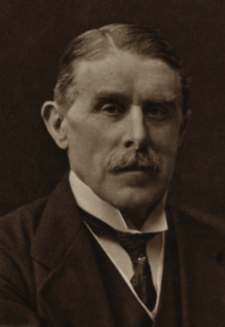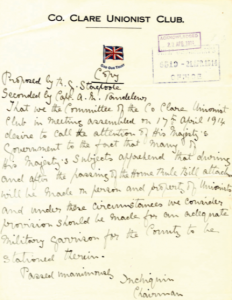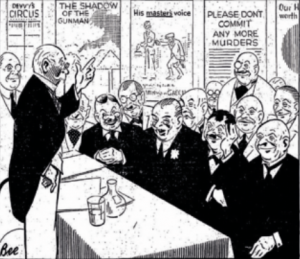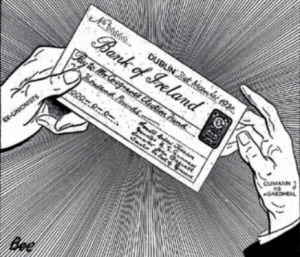The dog that didn’t bark: Southern unionism in pre- and post-revolutionary Ireland
Published in 20th-century / Contemporary History, Features, Issue 4 (July/August 2015), Volume 23Writing in the 1960s, F.S.L. Lyons compared the unionist reaction to the establishment of the Irish Free State to the dog in the night in the Sherlock Holmes story, its significance being that it didn’t bark. ‘Broadly speaking,’ Lyons concludes, ‘one may say of the ex-unionist or loyalist minority that the most important thing about it is that it too hasn’t barked since the Treaty.’
What happened to the unionist vote, and how can we explain what seems to be the inexplicable evaporation of Southern unionism? As any physics student will demonstrate, energy does not cease to exist, it merely changes form, and the same can also apply to politics. Southern unionism didn’t die; its energies were constantly redirected as political circumstances in Ireland evolved.

William St John Fremantle Brodrick, 1st Earl of Midleton—vehemently rejected the partitionist designs of Ulster unionists at the Irish Convention of 1917 and reached an accommodation with John Redmond. (National Portrait Gallery, London)
At first, Southern unionists attempted to hold all Irish opponents of Home Rule together in one broad-based movement encompassing the whole island, but this effort proved unsuccessful. The willingness of Ulster Unionists to contemplate partition, with the attendant result of condemning to political impotence those unionists left behind, caused a rift with their north-eastern brethren and a corresponding move towards an accommodation with the Home Rulers. The Easter Rising completed the transition. Southern unionists realised that an agreement would have to be made with John Redmond in order to bolster constitutional nationalism lest Ireland fall into the hands of revolutionaries and republicans.
Reappraisal at 1917 Irish Convention
This pessimistic fatalism was balanced by a sense of opportunity engendered by the menacing growth of Sinn Féin. It was felt that nationalists of the Irish Parliamentary Party would now have to look for allies to maintain their position, and that they would need—and be eager to obtain—the cooperation of Southern unionists. Unionists need not be reduced to impotence in a Dublin parliament, for to win unionist support nationalists would be willing to make concessions to them in any Home Rule scheme. Most concluded now that their best interests could be served by some form of self-government that would supplant the 1914 Act, prevent partition and contain adequate safeguards for unionists. The opportunity to act on this reappraisal of political realities came in 1917 with the hastily arranged Irish Convention. During the deliberations, Southern unionists joined the Home Rulers in vehemently rejecting the partitionist designs of the Ulster unionists, and agreement was reached between Redmond and Lord Midleton, with the latter accepting a settlement that would establish an Irish parliament with broad powers which, in return, would offer safeguards to unionists and protect imperial interests.

An April 1914 letter to the British government from Lord Inchiquin requesting a military garrison in County Clare in the event of Home Rule becoming law. (NAI)
This developing policy of rapprochement with their erstwhile adversaries was suddenly surpassed by political events, however, most importantly by the eclipse of the Redmondites at the 1918 general election as they fell victim to a resurgent Sinn Féin party, which secured a landslide victory. Indeed, by delaying an accommodation with Redmond for so long, Southern unionists had inadvertently abetted the rise of militant nationalism. Once again they were forced to adapt to a rapidly changing political environment. Many made the transition with surprising alacrity, revising their policies, and what was once unthinkable suddenly became politically viable. With the War of Independence in full swing, the British government could not afford Southern unionists adequate protection, and many concluded that the only safeguard of value to the Southern minority would be the goodwill of their fellow countrymen. ‘Granted that goodwill,’ the 7th earl of Wicklow wrote to Midleton, ‘no paper safeguards are necessary, without it they are useless.’ Or, as another Southern unionist put it, ‘The [British] government can’t protect us or govern the country. Sinn Féin is doing the latter and seems disposed to do the former. Won’t it suit my book to make friends with Sinn Féin.’
By 1919, those seeking accommodation had broken away from the Irish Unionist Alliance (IUA)—which remained bitterly opposed to any compromise—and formed a new body, the Unionist Anti-Partition League (UAPL), to win a place for themselves in the new Ireland that now appeared inevitable. Then, to their disbelief and indignation, came partition. Southern unionists found themselves in the most undesirable position imaginable. They were now an electorally insignificant group in a partitioned Ireland ruled by republicans. As before, pragmatism won the day. The aim of the abandoned Southern unionists was to make the best of their lot and secure the most advantageous deal possible. Their efforts in this direction met with considerable success. The Southern unionists were essentially a ruling élite imbued with the confidence that came from a history of economic, social and political dominance, and of governing. It was this self-perception that enabled them to make demands for extraordinary safeguards. The composition of the senate, in which half the seats were reserved for unionists, and the employment of a proportional representation electoral system were notable achievements, particularly when compared with the lack of parallel concessions to the much larger nationalist minority in Northern Ireland.
Treaty split
The Treaty split provided Southern unionists with a choice between two competing factions. They quickly realised that they would be forced to make vital decisions regarding their political, social and economic future. Abandoned by their supporters in Britain and the North, they would have to ingratiate themselves with new allies in the Free State in order to protect their interests. Within weeks of the signing of the Treaty, the IUA’s London representative, Richard Dawson, outlined to the Southern unionist organisation the courses open to them in the wake of the establishment of the Free State. ‘For the first time in the long Irish controversy,’ he noted, ‘the political ideals and the material interests of Unionism are in opposition.’ In an admission of breath-taking frankness, Dawson argued that ‘to attain their political ideals . . . they [Southern unionists] must sacrifice their mat-erial interests, to retain their means of living they have to support a form of Government which they hate’. In other words, if unionists were not to lose their economic status they would have to support the Free State. Dawson noted disdainfully that many unionists had already come forward ‘with effusive professions of loyalty and confidence in the Provisional Government’, and that more still of a more obstinate hue might yet offer support motivated by self-interest and a sense of betrayal by the British government. He argued against such premature professions of loyalty on tactical grounds. The support of those who had so readily discarded their former convictions would be suspect to the Sinn Féin leaders, and their bargaining power would be improved by holding out for better terms. In addition, it would be prudent to wait and see how the situation developed, as there was no surety ‘that the government of today will be the government of this day six months’.
The split within the republican movement over the Treaty presented Southern unionists with an opportunity similar to that of the 1917 Irish Convention, but with the prospect of securing something more durable from a more permanent partner. Midleton’s 1917 deal had been with a desperate Irish Parliamentary Party on its last legs. In the aftermath of the Treaty split, Southern unionists could now align themselves with a party whose political star was in the ascendant. While at this time the IUA flirted with the idea of establishing a conservative party to ‘enlist the sympathy of the property owning classes irrespective of politics’, it never took off.

In the run-up to the 1932 general election the Irish Press published a confidential circular from a committee composed mainly of ex-unionists soliciting financial support for Cumann na nGaedheal. (Irish Press, 12 December 1931)
Cumann na nGaedheal—a conservative political home
The pro-Treaty party, later to become Cumann na nGaedheal, offered the requisites desired by Southern unionists seeking a conservative political home. It presented itself as the party of stability, of law and order, of financial rectitude, and the party willing to retain Irish membership of the British Commonwealth. Moreover, this party was appealing for support to counteract the activities of an unreconstructed Sinn Féin and IRA alliance that sought to sever the links with Britain, to ‘break up the ranches’, which was considered a thinly veiled attack on unionist landed interests, and to initiate a protectionist economic policy that would destroy the interests of large farmers and the wealth of those who depended on the continuance of a vibrant trade relationship with the British Empire. That unionists would take the side of the Free State was made clear within a month of the Dáil’s approval of the Treaty in a letter from the IUA’s honorary treasurer, Fane Vernon, to the secretary of the organisation, J.E. Walsh. Vernon pointed out that the British government had ‘thrown them to the wolves’ and that ‘nothing is left but to make the best of a bad bargain’. Irish businessmen had been ‘left to shift for themselves’, and so as to ‘look after their own interests’ they should ‘endeavour to help the rulers of the Free State’.
Throughout the early 1920s, areas that had a high concentration of unionists tended to return independent candidates, who, while supportive of the government, were able to retain a degree of autonomy. The entry of Fianna Fáil into the Dáil in August 1927, however, suddenly and fundamentally altered the position of these independent deputies. Cumann na nGaedheal had not been jeopardised by the plethora of independents, but de Valera’s decision to enter the legislature exposed Cumann na nGaedheal’s minority party status. Kurt Bowen notes that with the ‘frightening prospect of Fianna Fáil becoming the legitimate government of the state . . . the primary and most pressing need was felt to be the election of a Cumann na nGaedheal government’. For the Church of Ireland Gazette the issue was clear: ‘It is Fianna Fáil versus Christendom’, it declared, and went on to recommend that independents and smaller parties ‘ought to disappear out of the minds of the electors’.

A post-election cartoon. (Irish Press, 15 February 1932)
The survival of the Cumann na nGaedheal government in the crucial Dáil vote of 16 August 1927 hinged on unionist support. The unionists of Trinity College and the independents rowed in behind the government party, and all but one subsequently joined Cumann na nGaedheal. These new recruits contained individuals like Henry Dockrell, who had a prominent family background in unionist politics, who had associated themselves with putting down the Easter Rising. The most prominent of the new members, however, was Major Bryan Cooper, a former Conservative MP for County Dublin, who had been one of a small minority of MPs who had voted against the removal of anti-Catholic phrases in the British monarchy’s coronation oath. The anti-nationalist backgrounds of these new Cumann na nGaedheal TDs was seized upon by Fianna Fáil, who claimed that there were now only two choices in Irish politics: Fianna Fáil, ‘who stand for Ireland’, and the ‘Cooper–Cosgrave Party who stand for England’s interest in Ireland’. Seán Lemass claimed that Free State leader W.T. Cosgrave was a puppet of ‘the leaders of England’s faithful garrison in the past’, and for this reason ‘every man and woman who was proud of Irish nationality had deserted him’ (The Nation, 10 September 1927).
The Cumann na nGaedheal party that contested the 1927 and 1932 elections was substantially different from that which emerged from the pro-Treaty side of the revolutionary Sinn Féin party during the tumultuous years of 1921–3. But while individuals of a unionist background would continue to play a disproportionate role in the economy, finance, banking, large-scale farming and, most strikingly, in the top echelons of the legal profession, they had ceased to be an organised political force in their own right.
Donnacha Ó Beacháin is Director of Research at the School of Law and Government, Dublin City University.
Further reading
K. Bowen, Protestants in a Catholic state: Ireland’s privileged minority (Kingston and Montreal, 1983).
P. Buckland, Irish Unionism 1885–1923: a documentary history (Belfast, 1973).
F.S.L. Lyons, ‘The minority problem in the 26 counties’, in F. MacManus (ed.), The years of the great test 1926–1939 (Cork, 1967).
M. McConville, Ascendancy to oblivion: the story of the Anglo-Irish (London, 1986).
















